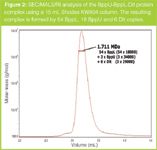Mega-Dalton Protein Complexes Characterization
The Application Notebook
Recent technological advances in macromolecular crystallography led to focus on the study of more and more sophisticated biological systems, such as protein–protein complexes. Nevertheless, they represent one of the most challenging areas in modern structural biology.
Wyatt Technology Corporation, Santa Barbara, California, USA.
Recent technological advances in macromolecular crystallography led to focus on the study of more and more sophisticated biological systems, such as protein–protein complexes. Nevertheless, they represent one of the most challenging areas in modern structural biology.
Baseplates are large multi-protein assemblies found at the tip of bacteriophage tails, which constitute key components during host infection. In Gram-positive bacteria, infection is initiated by binding of the phage receptor binding protein (RBP, BppL trimer) to a saccharidic receptor on the host surface. Several RBPs are present in each baseplate. A detailed analysis of these complexes would result in a better understanding of the mechanisms underlying phage–host interaction.
We report here a method to characterize protein–protein interactions and stoichiometry in Mega-Dalton macromolecular assemblies as illustrated by the study of the TP901-1 lactococcal phage baseplate. Our set-up involves the combined measurements from MALS, QELS, refractometry and UV280 nm absorbance coupled on-line with an analytical SEC.
First, we confirmed that BppL is homotrimeric in solution, as observed in the crystal structure. Then, operon co-expression of BppU and BppL proteins resulted in a complex containing 9 BppL and 3 BppU copies (Figure 1).

Figure 1
Then, co-expressing BppL, BppU and Dit proteins in the same way yielded a 1.7 MDa complex constituted by 54 BppL, 18 BppU and 6 Dit copies (Figure 2) and characterized by Rh and Rg values of 12.5 nm and 11.4 nm, respectively.

Figure 2
These data provided a picture of how these proteins assemble to form a baseplate and that 54 host binding sites are displayed by this phage suggesting that avidity contribute to host anchoring.
The reported method illustrates the characterization of giant macromolecular complexes providing their size and stoichiometry in solution. When studying such high molecular-weight protein complexes (Rg > 8 nm), the Rg becomes accessible, in contrast to normal-size proteins. We describe here the biggest macromolecular entity, to our knowledge, characterized to date using this approach.
This note graciously submitted by David Veesler, Architecture et Fonction des Macromolécules Biologiques, Unité Mixte de Recherches UMR6098, CNRS,Université de Provence Université de la Méditerranée, Marseille, France.

Wyatt Technology Corporation
6300 Hollister Avenue, Santa Barbara, California 93117, USA
tel. +1 805 681 9009 fax +1 805 681 0123
Website: www.wyatt.com















